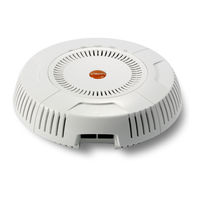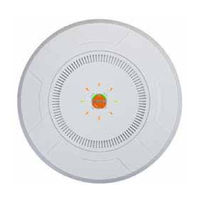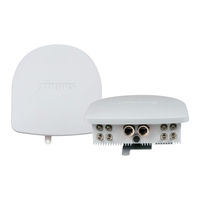Xirrus XR Series Manuals
Manuals and User Guides for Xirrus XR Series. We have 4 Xirrus XR Series manuals available for free PDF download: User Manual, Quick Installation Manual
Xirrus XR Series User Manual (662 pages)
Brand: Xirrus
|
Category: Wireless Access Point
|
Size: 9 MB
Table of Contents
-
-
Introduction
27-
-
Nomenclature28
-
-
-
-
Fast Roaming46
-
-
Organization51
-
-
-
-
-
Placement60
-
RF Patterns61
-
Acexpress76
-
WDS Planning89
-
-
User Interfaces103
-
Logging in106
-
Starting the WMI106
-
Licensing106
-
-
An Overview112
-
User Interface115
-
Logging in118
-
-
-
Admin History130
-
Network131
-
Network Map132
-
ARP Table136
-
Routing Table136
-
DHCP Leases137
-
CDP List138
-
LLDP List139
-
Undefined Vlans140
-
IAP Monitoring142
-
Rogues146
-
Channel History148
-
Radio Assurance150
-
Stations153
-
Location Map155
-
Rssi158
-
Noise Floor161
-
Max by IAP163
-
VLAN Statistics169
-
WDS Statistics170
-
IDS Statistics171
-
-
-
Figure 185. WDS187
-
-
Express Setup189
-
Network195
-
Interfaces196
-
DNS Settings206
-
LLDP Settings208
-
Services211
-
Netflow215
-
Wi-Fi Tag216
-
Location217
-
System Log219
-
Snmp223
-
DHCP Server226
-
Proxy Services228
-
Vlans239
-
VLAN Pools241
-
VLAN Management242
-
Tunnels246
-
SSID Assignments249
-
Security250
-
Admin Management256
-
Admin Privileges258
-
Admin RADIUS260
-
Global Settings275
-
External Radius279
-
Internal Radius283
-
Active Directory285
-
Ssids293
-
SSID Management302
-
Active Iaps323
-
Honeypots325
-
Personal Wi-Fi327
-
Groups329
-
Using Groups330
-
Group Management331
-
Group Limits334
-
Figure 165. Iaps336
-
Iaps336
-
IAP Settings338
-
Global Settings344
-
RF Monitor384
-
RF Resilience385
-
Hotspot 2.0392
-
NAI Realms395
-
Nai Eap396
-
Dos Attacks399
-
LED Settings404
-
DSCP Mappings405
-
Roaming Assist406
-
Wds409
-
WDS Client Links411
-
Filters415
-
Filter Lists416
-
Clusters425
-
Airwatch430
-
Mobile430
-
-
-
-
System Tools436
-
System438
-
Diagnostics445
-
Network Tools448
-
Cli450
-
Options457
-
Logout458
-
-
-
-
Show Commands469
-
-
Acl476
-
Admin477
-
Auth478
-
Cdp478
-
Clear480
-
Cluster482
-
Contact-Info483
-
Date-Time484
-
Dhcp-Server485
-
Dns486
-
File487
-
Filter491
-
Air Cleaner492
-
Group495
-
Hostname495
-
Interface496
-
Load497
-
Location497
-
Management499
-
MDM501
-
More502
-
Netflow503
-
Quick-Config505
-
Quit506
-
Reboot508
-
Reset508
-
Restore509
-
Roaming-Assist510
-
Run-Tests511
-
Security513
-
Snmp514
-
Ssid515
-
Syslog516
-
Tunnel517
-
Uptime518
-
Vlan518
-
Wifi-Tag519
-
-
-
Appendices
535 -
-
-
Host Name537
-
Serial537
-
Ntp538
-
Server Settings538
-
Syslog538
-
Dhcp539
-
Snmp539
-
Default SSID540
-
Security540
-
Internal RADIUS542
-
Management542
-
-
-
-
-
Multiple Ssids546
-
Security548
-
VLAN Support551
-
-
-
Advertisement
Xirrus XR Series User Manual (200 pages)
Wireless Arrays and Access Points
Brand: Xirrus
|
Category: Speaker System
|
Size: 3 MB
Table of Contents
-
Introduction
23-
-
-
Organization43
-
-
-
-
-
Placement52
-
RF Patterns53
-
-
-
WDS Planning76
-
-
Logging in93
-
Licensing93
-
-
An Overview102
-
User Interface106
-
Logging in110
-
-
-
Array Summary114
-
Admin History122
-
-
-
Network123
-
Network Map124
-
ARP Table128
-
Routing Table128
-
DHCP Leases129
-
CDP Neighbors130
-
Undefined Vlans132
-
-
Iaps134
-
Channel History140
-
Radio Assurance142
-
-
-
Stations145
-
Location Map147
-
Rssi151
-
Noise Floor154
-
Max by IAP156
-
-
-
VLAN Statistics163
-
WDS Statistics164
-
IDS Statistics165
Xirrus XR Series Quick Installation Manual (27 pages)
Wireless Arrays
Brand: Xirrus
|
Category: Wireless Access Point
|
Size: 1 MB
Table of Contents
Advertisement
Xirrus XR Series Quick Installation Manual (19 pages)
Wireless Arrays
Brand: Xirrus
|
Category: Speaker System
|
Size: 0 MB
Table of Contents
-
Drawings14



